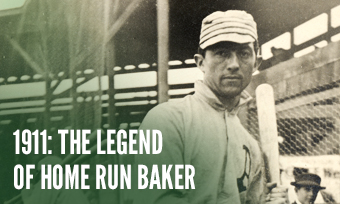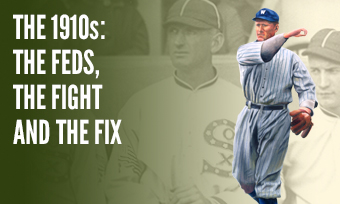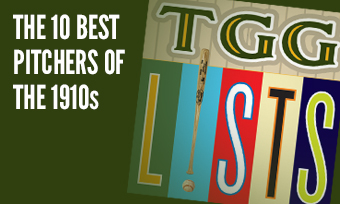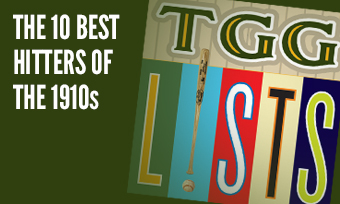The Yearly Reader
Leaders and Honors, 1911
Our list of baseball’s top 10 hitters and pitchers in both the American League and National League for the 1911 baseball season, as well as the awards and honors given to the game’s top achievers of the year.
The National League’s Top 10 Hitters, 1911
Bold type in brick red indicates league leader.
1. Wildfire Schulte, Chicago
Key Numbers: .300 average, 105 runs, 30 doubles, 21 triples, 21 home runs, 107 RBIs, 76 walks, .534 slugging percentage.
A monster year by Deadball Era standards: Schulte became the first major leaguer in the 20th Century to reach 20 homers, the first player ever to collect at least 20 doubles, triples and homers each in the same year, belted the only four grand slams of his career and, proving he could do it all, finished second in the NL with 31 sacrifice bunts.
2. Larry Doyle, New York
Key Numbers: .310 average, 102 runs, 25 doubles, 25 triples, 13 home runs, 77 RBIs, 71 walks, 38 stolen bases.
Two things were on fire at the Polo Grounds: One was the ballpark itself, the other was Doyle, who arguably put together his best season yet.
3. Honus Wagner, Pittsburgh
Key Numbers: .334 average, 87 runs, 23 doubles, 16 triples, 9 home runs, 89 RBIs, 67 walks.
Wagner won his eighth and final batting crown, thanks in part to a forfeited game that erased a 0-for-4 and preserved his lead by a single point over Boston’s Doc Miller.
4. Jimmy Sheckard, Chicago
Key Numbers: .276 average, 121 runs, 26 doubles, 11 triples, 147 walks, 32 stolen bases, .434 on-base percentage.
After five years of standard results, Sheckard displayed more patience at the plate and was rewarded with a then-NL record 147 walks and NL-leading 121 runs scored.
5. Sherry Magee, Philadelphia
Key Numbers: .288 average, 32 doubles, 15 home runs, 94 RBIs.
In any other Deadball Era season, Magee might have run away with the NL home run crown, but his 15—10 of which were hit at his home park of Baker Bowl—were a distant second to Schulte.
6. Bob Bescher, Cincinnati
Key Numbers: .275 average, 106 runs, 32 doubles, 10 triples, 102 walks, 78 strikeouts, 81 stolen bases.
Bescher’s 81 steals would stand as a NL record until Maury Wills broke it 51 years later.
7. Red Murray, New York
Key Numbers: .291 average, 27 doubles, 15 triples, 78 RBIs, 48 stolen bases.
On a Giants roster obsessed with stolen bases, Murray’s 48 were good enough to only place fourth on the team.
8. Ed Konetchy, St. Louis
Key Numbers: 158 games, .289 average, 90 runs, 38 doubles, 13 triples, 6 home runs, 88 RBIs, 81 walks.
The Cardinals’ main bopper for the moment, who was said to be nicknamed the Bohemian Candy Dropper (wow), was on top of his game in 1911.
9. Chief Wilson, Pittsburgh
Key Numbers: .300 average, 34 doubles, 12 triples, 12 home runs, 107 RBIs.
Called “Chief” not because of any Native American heritage but as a reference to law enforcement in his native Texas, Wilson displayed much of the offensive spunk that long buoyed teammate Honus Wagner.
10. Doc Miller, Boston
Key Numbers: .333 average, 192 hits, 36 doubles, 7 home runs, 91 RBIs, 32 stolen bases.
The man who barely lost the NL batting crown to Wagner was a lone bright spot on a miserable (44-107) Rustlers team. It was his second of four NL teams he’d play for in a short five-year career before becoming—you guessed it—a doctor.
The American League’s Top 10 Hitters, 1911
1. Ty Cobb, Detroit
Key Numbers: .419 average, 148 runs, 248 hits, 47 doubles, 24 triples, 8 home runs, 127 RBIs, 83 stolen bases, .620 slugging percentage.
Thanks to the introduction of a juiced-up ball in the AL, Cobb put up the most prolific numbers of his legendary career.
2. Joe Jackson, Cleveland
Key Numbers: .408 average, 126 runs, 233 hits, 45 doubles, 19 triples, 7 home runs, 83 RBIs, 41 stolen bases, .468 on-base percentage.
An astounding rookie showing for the ill-fated Shoeless Joe; he’s the only major leaguer to ever bat .400 and not win a batting title.
3. Sam Crawford, Detroit
Key Numbers: .378 average, 109 runs, 217 hits, 36 doubles, 14 triples, 7 home runs, 115 RBIs, 37 stolen bases.
Along with Cobb and Jackson, Crawford set a career high in batting average—and by 43 points over his second-best performance, back in 1903.
4. Birdie Cree, New York
Key Numbers: .348 average, 90 runs, 181 hits, 30 doubles, 22 triples, 88 RBIs, 48 stolen bases.
Birdie tweeted the sweetest baseball song of his career before it all went sour over the next four years due to injury, illness and lack of exercise.
5. Frank Baker, Philadelphia
Key Numbers: .334 average, 96 runs, 198 hits, 42 doubles, 14 triples, 11 home runs, 115 RBIs, 38 stolen bases.
The young third baseman ramped up the power and led the AL in homers for the first of four straight years, an achievement accomplished by fading 38-year-old teammate Harry Davis years before.
6. Eddie Collins, Philadelphia
Key Numbers: .365 average, 92 runs, 180 hits, 13 triples, 73 RBIs, 38 stolen bases.
Fast Eddie had to settle for fourth in the AL batting race despite a .365 average that was the second-best of his Hall-of-Fame career.
7. Tris Speaker, Boston
Key Numbers: .334 average, 88 runs, 34 doubles, 13 triples, 8 home runs, 70 RBIs.
Speaker joined Cobb and Jackson in hitting .400—against Washington, that is. He batted .405 against the Senators—or .462 when Walter Johnson didn’t start.
8. Jim Delahanty, Detroit
Key Numbers: .339 average, 83 runs, 184 hits, 30 doubles, 14 triples, 94 RBIs.
One of five brothers to play MLB and sputtering around the bigs for 10 years, Delahanty finally scored a hit with the Tigers—his seventh team.
9. Danny Murphy, Philadelphia
Key Numbers: .329 average, 104 runs, 27 doubles, 11 triples, 6 home runs.
In his last full season as a major leaguer—before a broken kneecap the following year made him a quality bench player—the 35-year-old Murphy saved his best for last, setting career highs in batting average, runs and walks (50).
10. Clyde Milan, Washington
Key Numbers: 154 games, .315 average, 616 at-bats, 109 runs, 194 hits, 74 walks, 58 stolen bases.
The speedy outfielder flourished into a rare, early offensive threat for the woebegone Senators—and gave the underappreciated-to-date Walter Johnson some overdue and much-needed support.
The National League’s Top 10 Pitchers, 1911
1. Pete Alexander, Philadelphia
Key Numbers: 2.57 ERA, 28 wins, 13 losses, 48 appearances, 31 complete games, 7 shutouts, 367 innings.
The Phillies downplayed concerns about Alexander’s drinking habits and dished out the best $750 they would ever spend to acquire him from the minors.
2. Christy Mathewson, New York
Key Numbers: 1.99 ERA, 26 wins, 13 losses, 29 complete games, 307 innings, 38 walks.
Not as sharp with the fastball but definitely more accurate, Mathewson began to cut down on the walks and logged his fourth straight sub-2.00 ERA.
3. Babe Adams, Pittsburgh
Key Numbers: 2.33 ERA, 22 wins, 12 losses, 6 shutouts, 293.1 innings.
Like Mathewson, Adams also began to give away far fewer free passes—it would get even better in the years to come—and set a personal best with 22 wins.
4. Rube Marquard, New York
Key Numbers: 2.50 ERA, 24 wins, 7 losses, .774 win percentage, 277.2 innings, 237 strikeouts.
Marquard’s sudden success could be attributed to the arrival of coach Wilbert Robinson, who was specifically signed on by John McGraw to tutor the young pitcher.
5. Lew Richie, Chicago
Key Numbers: 2.13 ERA, 15 wins, 11 losses, 253 innings.
Six of Richie’s 15 wins came against the Giants; when he won five more the next season against New York, he developed a reputation as the “Giant Killer.”
6. Three Finger Brown, Chicago
Key Numbers: 2.80 ERA, 21 wins, 11 losses, 13 saves, 53 appearances, 270 innings.
As sunset beckoned for the 35-year-old Brown, he won another 20-plus games but relieved as often as he started—saving 13 games to establish a new record.
7. Bobby Keefe, Cincinnati
Key Numbers: 2.58 ERA, 22 wins, 15 losses, 6 shutouts, 283 innings, 185 strikeouts.
Son of a California gold rush prospector, Keefe briefly struck it rich in the majors in a short stint sandwiched by long stretches in the minors.
8. Nap Rucker, Brooklyn
Key Numbers: 2.71 ERA, 22 wins, 18 losses, 48 appearances, 315.2 innings.
After the tough-luck Superbas ace lost his first six starts of the year and muttered, “Here we go again,” he rebounded nicely to grab his lone 20-win campaign and a rare above-.500 finish.
9. Lefty Leifield, Pittsburgh
Key Numbers: 2.63 ERA, 16 wins, 16 losses, 318 innings.
The end of the line for the southpaw (as if the name didn’t give it away), capping a six-year run in which he won 103 games before a dead arm temporarily killed his big-league career. He made a small comeback with the St. Louis Browns from 1918-20.
10. Bob Harmon, St. Louis
Key Numbers: 3.13 ERA, 23 wins, 16 losses, 51 appearances, 41 starts, 28 complete games, 348 innings, 181 walks.
Securing the only winning season in a nine-year career, Harmon managed despite walking 181 batters—the most by a modern-era major leaguer until Bob Feller came along.
The American League’s Top 10 Pitchers, 1911
1. Ed Walsh, Chicago
Key Numbers: 2.22 ERA, 27 wins, 18 losses, 4 saves, 56 appearances, 368.2 innings, 255 strikeouts.
The typically sleepwalking White Sox offense awoke to give Ed Walsh long-overdue support.
2. Smoky Joe Wood, Boston
Key Numbers: 2.02 ERA, 23 wins, 17 losses, 275.2 innings, 231 strikeouts.
The Red Sox were thrilled with what they thought was his breakout campaign. They had no idea. (See 1912.)
3. Vean Gregg, Cleveland
Key Numbers: 1.80 ERA, 23 wins, 7 losses, .767 win percentage, 244.2 innings.
Had it not been for the tragic death of Addie Joss, rookie southpaw Vean Gregg would have given the Naps one of the game’s best one-two punches on the mound.
4. Walter Johnson, Washington
Key Numbers: 1.90 ERA, 25 wins, 13 losses, 36 complete games, 6 shutouts, 322.1 innings, 17 wild pitches.
Saddled by horrible run support in his early years, Johnson was finally given love from his teammates with an average of nearly five runs per start—the highest he received until more live-ball times in the 1920s. (Also to note; deduct Johnson’s 25-13 record from the Senators’ ledger, and they’re 39-77.)
5. Russ Ford, New York
Key Numbers: 2.27 ERA, 22 wins, 11 losses, 281.1 innings.
Solid sophomore campaign for the AL Rookie of the Year of 1910—that is, if the honor had existed.
6. Eddie Plank, Philadelphia
Key Numbers: 2.10 ERA, 23 wins, 8 losses, 4 saves, 6 shutouts, 256.2 innings.
The reliable, ever-constant A’s ace was a little frisky to boot; he was ejected for the only time in his career.
7. Chief Bender, Philadelphia
Key Numbers: 2.16 ERA, 17 wins, 5 losses, .773 win percentage.
Plank’s long-time teammate continued to rack up one win after another while rarely losing; his 17-5 mark made it 58-18 for three seasons running.
8. Jack Coombs, Philadelphia
Key Numbers: 3.53 ERA, 28 wins, 12 losses, 40 starts, 336.2 innings.
Coombs gave up nearly three times as many earned runs than during his phenomenal 1910 outburst, but he still managed to win nearly as many games.
9. Ray Collins, Boston
Key Numbers: 2.40 ERA, 11 wins, 12 losses.
In a year where offense took a healthy upswing, the Red Sox’ lefty must have been wondering, “Where’s my cut of all of this?”
10. Jim Scott, Chicago
Key Numbers: 2.39 ERA, 14 wins, 11 losses.
The Bret Saberhagen of his time—up one year, down the next, and so on—Scott enjoyed the upside of the parabolic with a modest but sharp effort.









